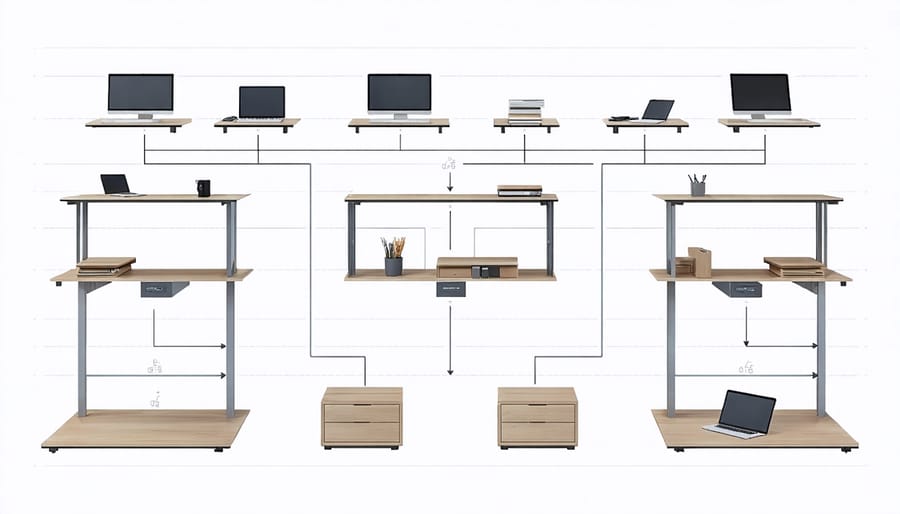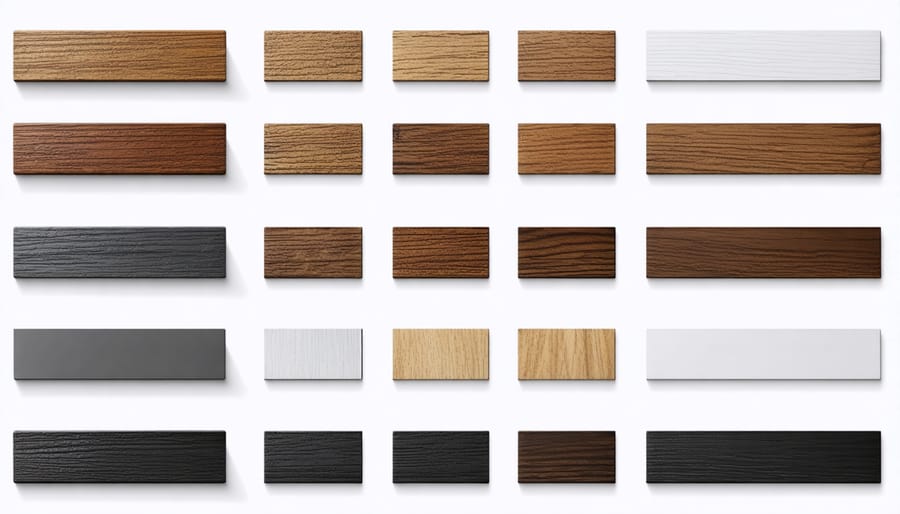Transform your workspace instantly with modular desk solutions that adapt to any room size and work style. Custom-configure desk segments, storage units, and accessories to create a personalized command center that evolves with your needs. Like many successful modular furniture projects, a well-designed desk system combines functionality with style, maximizing both productivity and available space.
Modern modular desks offer unprecedented flexibility, featuring interchangeable components that can be rearranged as your workspace requirements change. From L-shaped configurations for corner spaces to expandable straight designs for growing home offices, these adaptable solutions provide smart storage, ergonomic comfort, and seamless integration with existing décor. Whether you’re setting up a compact home office or designing an expansive workstation, modular desk systems deliver the perfect balance of form and function while ensuring your investment remains valuable for years to come.
What Makes a Desk Truly Modular?
Key Components and Features
A well-designed modular desk consists of several essential components that work together to create a versatile workspace. The desktop surface forms the foundation, typically available in various materials like engineered wood, bamboo, or laminate. These surfaces often feature pre-drilled holes or connecting mechanisms that allow for easy attachment of other components.
Support structures are another crucial element, including adjustable legs, brackets, and frame systems that provide stability while maintaining the desk’s modular nature. Many modern designs incorporate cable management solutions, such as built-in grommets or attachable trays, keeping your workspace tidy and organized.
Storage components play a vital role in modular desk systems. These include detachable drawers, floating shelves, and mobile pedestals that can be added or removed as needed. Additional accessories like monitor arms, keyboard trays, and CPU holders can be integrated seamlessly into the system.
What makes these desks truly modular is their connecting hardware – specially designed brackets, clips, and fasteners that allow for tool-free assembly and reconfiguration. Look for components with universal mounting systems, as these offer the most flexibility for future modifications and upgrades.

Customization Options
The beauty of modular furniture desks lies in their incredible flexibility when it comes to customization. You can tailor your desk setup to match both your space and needs perfectly. Start with the desktop size – most systems offer various width and depth options, from compact 36-inch surfaces to expansive 72-inch workspaces. Choose from different materials like solid wood, laminate, or glass to match your style and budget.
Storage components are highly customizable too. Mix and match drawer units, file cabinets, and open shelving to create your ideal organization system. Many modular systems offer accessories like keyboard trays, monitor arms, and cable management solutions that can be added or removed as needed.
The leg system is another customizable element. Select from various heights to create either a sitting or standing desk, and choose styles ranging from minimalist metal frames to industrial-look legs with adjustable feet. Color coordination is also flexible – many manufacturers offer multiple finishes for both the desk surface and supporting elements, allowing you to create a cohesive look or an intentionally contrasting design.
Remember that most modular systems allow you to add or modify components over time, so you can start with basics and expand as your needs change.
Designing Your Perfect Modular Desk Setup
Space Assessment
Before diving into modular desk options, it’s crucial to thoroughly assess your available space. Start by clearing the intended area and taking precise measurements of the length, width, and height. Remember to account for door swings, window locations, and traffic flow patterns in your room. A good rule of thumb is to leave at least 3 feet of clearance space around your desk for comfortable movement.
Consider the room’s shape and any architectural features that might affect your desk placement, such as electrical outlets, heating vents, or built-in elements. Take note of natural light sources – positioning your desk near a window can create an inspiring workspace while reducing the need for artificial lighting.
To better visualize your space, create a simple floor plan using graph paper or a digital planning tool. This will help you maximize small spaces and experiment with different configurations before making any purchases. Don’t forget to measure doorways and stairwells to ensure your modular pieces can be easily transported to their final location.
Remember to think vertically as well – modular desks often come with stackable components that can utilize wall space effectively, making them perfect for rooms with limited floor area.
Workflow Optimization
The key to maximizing your modular desk’s potential lies in thoughtfully arranging its components to match your unique workflow. Start by identifying your daily work patterns and the tasks you perform most frequently. This personalized approach ensures your desk setup supports rather than hinders your productivity.
Consider creating distinct zones for different activities. Place your most-used items within arm’s reach in what ergonomics experts call the “primary zone.” For instance, if you frequently switch between digital and paper tasks, arrange your modules to accommodate both a computer setup and a clear writing space.
Take advantage of vertical space by incorporating stackable modules. These minimalist organization solutions can help keep your workspace tidy while maintaining easy access to essential items. Try positioning frequently-used supplies in upper modules and archive materials in lower ones.
Think about your technology needs too. If you use multiple devices, arrange your modules to include dedicated charging stations and cable management solutions. Consider modules with built-in power strips or wire management features to keep your workspace clean and organized.
Don’t forget about lighting and comfort. Position your desk modules to maximize natural light while minimizing screen glare. If you often collaborate with others, arrange your modules to create a comfortable meeting space that can be easily transformed back into your personal workspace.
Remember that your needs might change over time, so periodically reassess your layout. The beauty of modular furniture is its flexibility – don’t hesitate to experiment with different configurations until you find your perfect setup.

Future-Proofing Your Design
When investing in a modular desk system, thinking ahead is crucial for maximizing its long-term value. Start by considering your future space requirements and how your work habits might evolve. Choose a desk system with standardized components that can be easily added or replaced, ensuring you won’t be stuck with an outdated setup as your needs change.
Look for manufacturers who maintain consistent product lines and offer backward compatibility with their components. This way, you can confidently expand your desk setup years down the line without worrying about mismatched pieces or discontinued parts.
Consider selecting neutral colors and timeless designs that won’t quickly go out of style. While trendy features might be tempting, classic elements tend to age better and provide more flexibility for future modifications. Pay attention to the quality of materials and construction methods – robust materials like solid wood or high-grade steel will maintain their integrity over time.
Think modularly about your power and cable management solutions too. Install systems that can accommodate additional devices and changing technology. Some forward-thinking features to consider include wireless charging pads, USB hubs, and easily accessible power strips that can be upgraded as needed.
Remember to leave some room for growth in your initial layout. Planning for extra space or potential additions will make future expansions smoother and more cost-effective. This might mean choosing slightly larger support pieces or ensuring your current configuration can accept additional modules without a complete overhaul.
Style Integration Tips

Material Selection
When it comes to creating your perfect modular desk, material selection plays a crucial role in both functionality and aesthetics. The most popular choice is engineered wood or MDF (Medium-Density Fiberboard), which offers an excellent balance of durability and affordability. These materials come in various finishes, from sleek white to warm wood tones, making it easy to match your existing décor.
For a more premium look and enhanced durability, solid wood options like oak, maple, or walnut are fantastic choices. While they come with a higher price tag, these materials age beautifully and can last for generations with proper care. If you’re aiming for a modern, industrial look, consider incorporating metal elements like steel or aluminum for the frame or accent pieces.
Laminate surfaces are particularly practical for work areas, offering excellent resistance to scratches and stains while being budget-friendly. For those environmentally conscious, bamboo and reclaimed wood options provide sustainable alternatives without compromising on style.
When selecting materials, consider your daily usage patterns. If you’ll be writing frequently, opt for smoother surfaces. For heavy computer use, choose materials that resist heat and are easy to clean. Don’t forget about the finish – matte surfaces hide fingerprints better, while glossy finishes can make a space feel more luxurious but require more maintenance.
Color Coordination
Creating a cohesive color scheme for your modular desk setup can transform your workspace from simply functional to visually stunning. Start by choosing a primary color for your larger desk components, such as the desktop and main storage units. Neutral tones like white, black, or wood finishes offer excellent versatility and longevity in your design.
For a harmonious look, follow the 60-30-10 rule: use your primary color for 60% of the desk setup, a secondary color for 30%, and an accent color for the remaining 10%. This could mean having a white desk base, gray storage modules, and burgundy accessories or organizers.
Consider your room’s existing color palette when selecting your desk components. Many modular systems offer mix-and-match pieces in complementary colors, making it easy to create a coordinated look. If you’re working with wood tones, try to match or intentionally contrast the undertones – warm with warm, or warm with cool for a deliberate contrast.
Don’t forget about hardware and accessories. Choosing consistent finishes for handles, legs, and other metal elements (like silver, black, or brass) helps tie everything together. Add personality through colorful desk accessories like pen holders, mouse pads, or desk mats, which can be easily changed when you want to refresh your look.
Remember that lighting can significantly affect how colors appear, so test your color combinations under your workspace’s actual lighting conditions before making final decisions.
Maintenance and Adaptability
Keeping your modular desk in top condition doesn’t have to be complicated. With regular maintenance and smart adaptability strategies, you can extend its lifespan and ensure it continues to meet your evolving needs. Start by dusting your desk components weekly using a microfiber cloth, paying special attention to joints and connection points where debris can accumulate.
For wooden components, apply furniture polish every three months to maintain their finish and prevent drying. Metal parts should be checked periodically for signs of rust or wear, especially in humid environments. If you notice any loose connections, tighten them promptly to prevent wobbling and potential damage to other components.
One of the greatest advantages of modular desks is their adaptability. As your needs change, you can incorporate innovative storage solutions by adding new modules or rearranging existing ones. Keep track of your manufacturer’s latest compatible components, as they often release new pieces that can enhance your setup.
Consider maintaining a small supply of matching fasteners and connectors, as these can wear out over time. Store assembly instructions and any specialized tools that came with your desk in a designated place for future reconfigurations. If you’re planning significant changes to your setup, take photos of the current assembly to use as a reference.
To protect surface finishes, use appropriate desk mats or pads in high-use areas. For adjustable components like height-adjustment mechanisms, regular lubrication according to manufacturer specifications will ensure smooth operation. When cleaning, avoid harsh chemicals that might damage surfaces or weaken connection points – stick to manufacturer-recommended cleaning products.
Remember that modular furniture is designed to evolve with you. Don’t hesitate to reconfigure your desk seasonally or annually to better suit your changing work patterns or space requirements. This flexibility is what makes modular desks a smart long-term investment in your workspace.
Embarking on your modular desk journey opens up a world of possibilities for creating a personalized, adaptable workspace that truly works for you. Throughout this guide, we’ve explored how modular furniture desks offer unmatched flexibility, allowing you to customize your workspace as your needs evolve. From choosing the right components and materials to considering ergonomic factors and aesthetic preferences, you now have the knowledge to make informed decisions about your ideal desk setup.
Remember that the beauty of modular furniture lies in its versatility. Whether you’re working with a compact urban apartment or a spacious home office, these adaptable solutions can be tailored to fit your space perfectly. Start small if you need to – perhaps with a basic desk configuration – and expand your setup gradually as your requirements change.
Don’t be afraid to experiment with different layouts and combinations. The modular nature of these desks means you can easily adjust, rearrange, and rebuild until you find the perfect configuration. Consider your current needs while planning for future adaptability, and remember that investing in quality components now will serve you well in the long run.
Take the first step today in creating your perfect workspace. With the right planning, components, and creativity, your modular desk will become more than just furniture – it’ll be a dynamic workspace that grows and changes with you.
